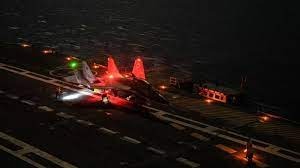To confront China in the Indo-Pacific, the Navy needs a third carrier and nuclear submarines
The Indian Navy has requested that the Modi government build another aircraft carrier, three nuclear-powered submarines, and six diesel-electric conventional submarines to beef up its strength in order to face the PLA challenge, as it is anticipated that the Chinese Navy will increase its footprint in the Indian Ocean through logistics support bases from the Straits of Malacca to Gulf of Aden. All of the building will be carried out in Indian shipyards and in accordance with PM Modi’s “Atmanirbhar Bharat” vision.
Beijing has turnaround logistics bases in Ream, Cambodia, close to the Straits of Malacca, a listening post at Coco Islands in the Bay of Bengal, a base in Hambantota, Sri Lanka, a base in Gwadar, Balochistan, a naval base in Jask, Iran, and a full-fledged berthing facility at Djibouti, which is located on the mouth of the Red Sea and entry into the Mediterranean Sea.
After shelving plans for a larger warship, three nuclear-powered conventionally armed submarines (SSN) in cooperation with important allies like France, and high-tech diesel-electric submarines under Project 76, it is believed that the Indian Navy brass informed the Modi government that it intended to move the Defence Acquisition Council (DAC) for acceptance of necessity (AON) of repeat order of a 45000 ton Vikrant class of aircraft carrier. The Indian Navy does not want holes in its capabilities and does not want to lose machine tooling skills owing to a shortage of contracts to shipyards like Kochi and Mazagon, according to the forecast that a Chinese carrier strike force might be patrolling high seas in the Indian Ocean as early as 2025–2026. While INS Vikrant is undergoing a regular maintenance check at Karwar Naval Base, India’s first aircraft carrier, INS Vikramaditya, is presently in service.
Indian intelligence indicates that Chinese aircraft carriers (Liaoning and Shandong) are capable of 24/7 fighter operations and that the PLA Navy is in the process of training naval fighter pilots. This is in contrast to attempts by Western media to downplay the capabilities of China’s strike force. The 80,000 ton, electro-magnetic catapult-equipped Fujian carrier, which is now under construction, will be able to threaten the US Navy’s might in the Indo-Pacific by the time it is ready for sea trials the following year.
While Paris is prepared to offer support and assist New Delhi in designing and building 5000 tons SSNs, similar to Suffren class, indigenously in India, India is in discussions with France to build an additional three Kalveri class submarines in Mazagon dockyards in Mumbai. These submarines will be equipped with air-independent propulsion for longer endurance. Additionally, if the Modi administration chooses to scrap Project 75 I, the French Naval company is prepared to co-design and construct Project 76 submarines, since the three extra Kalveri class submarines would feature DRDO developed and approved AIP. In Project 75 I, six diesel-electric submarines with AIP were planned.
India’s credible nuclear deterrent consists of three nuclear submarines of the Arihant class that are equipped with nuclear ballistic missiles. While the first is completely functional, the second is in the last stages of sea testing, and the third is likewise in the beginning stages of sea trials.
This strategic vacuum will be addressed by the Russian Akula class submarine, which India has already paid for being leased to the Indian Navy, even though the process to design and construct SSNs would take time. In 2025, it’s anticipated that the ship with ground assault missiles will join the Indian Navy.
The Quad has to be ready for a military emergency in Taiwan and India for a military surprise along its 3488 km line of real control with Tibet as the PLA quickly builds its capabilities on land and water in accordance with Chinese President Xi Jinping’s aspiration to become the world’s most powerful person. It is important to keep in mind that under J. L. Nehru, India acknowledged Tibet as a part of China, Beijing continues to see Arunachal Pradesh as a part of south Tibet, and India rejected the 1959 cartography line in East Ladakh as its boundary in occupied Aksai Chin.







